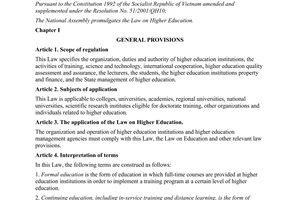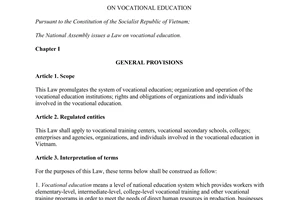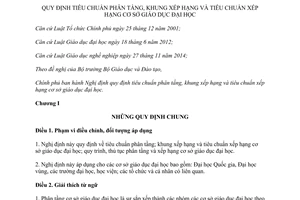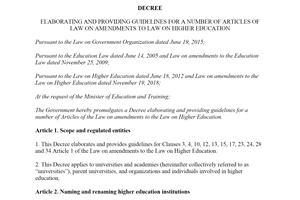Decree No. 73/2015/ND-CP standards for stratification framework ranking higher educational institutions đã được thay thế bởi Decree 99/2019/ND-CP providing guidelines Law on amendments to the Law on Higher Education và được áp dụng kể từ ngày 15/02/2020.
Nội dung toàn văn Decree No. 73/2015/ND-CP standards for stratification framework ranking higher educational institutions
|
THE GOVERNMENT |
THE SOCIALIST REPUBLIC OF VIETNAM |
|
No. : 73/2015/ND-CP |
Hanoi, September 08th 2015 |
DECREE
ON STANDARDS FOR STRATIFICATION, FRAMEWORK AND STANDARDS FOR RANKING HIGHER EDUCATIONAL INSTITUTIONS
Pursuant to the Law on Government organization dated December 25, 2001;
Pursuant to the Law on Higher Education dated June 18th 2012;
Pursuant to the Law on Vocational Education dated November 27th 2014;
At the request of the Minister of Education and Training,
The Government promulgates Decree on standards for stratification, framework and standards for ranking higher educational institutions.
Chapter I
GENERAL PROVISIONS
Article 1. Scope of regulation and regulated entities
1. This Decree provides for standards for stratification; framework and standards for ranking higher educational institutions; procedures for stratifying and ranking higher educational institutions.
2. This Decree applies to higher educational institutions including Vietnam National University, Regional universities, universities, institutes and relevant organizations and individuals.
Article 2. Interpretation of terms
1. Stratification of higher educational institutions means the classification of higher educational institutions by educational goals and orientation depending on standards according to regulations in this Decree. Higher educational institutions are divided into 3 layers: higher educational institutions orienting towards research; higher educational institutions orienting towards application and higher educational institutions orienting towards practice.
2. Ranking means the arrangement of higher educational institutions in descending order depending on their qualities that are calculated according to the framework of each layer of higher-education systems.
3. Framework means the upper limit and the lower limit calculated by points depend on which higher educational institutions are classified into groups in each layer of higher education system.
4. Training program orienting towards research is a training program whose goals and contents are established in orientation towards specializing in basic principles and theories in field of science and development of source technologies as the basis for developing applied science and technology.
5. Training program orienting towards application mean a training program whose goals and contents are established in orientation towards developing basic research findings, applying source technologies to create technological solutions and completed procedures for managing and designing tools to serve various needs of human.
6. Training program orienting towards practice means a training program whose goals and contents are established in orientation towards focusing on adoption of technological solutions, procedures for managing and producing tools basing on the designs to serve the production and life.
7. Full-time lecturers, full-time researchers
a) A full-time lecturer/full-time researcher of a public higher educational institution is a civil servant who is employed and managed according to legislation on civil servants;
b) A full-time lecturer/full-time researcher of a private higher educational institution is a lecturer/researcher who: (i) signs a 36-month labor contract or an indefinite labor contract according to regulations in the Labor Code; (ii) is not working for any other employer under a labor contract with a duration of 3 months or longer; (iii) is not an official or a civil servant. The higher education institution shall pay wages and other benefits to its employees in accordance with applicable regulations.
8. Criteria for stratification and ranking are requirements on a specific respect of a standard. Criteria for stratification and ranking include role in higher education system; scope, disciplines and training levels; structure of training and technologies; quality of training and scientific research; education quality inspection results.
Chapter II
STANDARDS FOR STRATIFICATION OF HIGHER EDUCATIONAL INSTITUTIONS
Article 3. Standards applicable to higher educational institutions orienting towards research
1. Role in higher education system
Are higher educational institutions having training and scientific research specialized in basic principles and theory in science for developing source technologies, providing human resources with capacity for teaching and basic research and for presiding over the handling of national and international scientific missions/projects.
2. Scope, disciplines and training levels
a) Training scope of training program orienting towards research in university, mastery and doctoral training of a higher educational institution shall have the greatest proportion in its training scope;
b) Scope of mastery and doctoral training shall be over 30% of the total scope of disciplines/specialities in orientation of research;
c) At least 3 specialities at university to doctoral training shall be in the field of basic science and applied basic science in 3 different groups of disciplines.
3. Structure of training and technologies
a) There shall be units for researches relating to the discipline like Research Institutes, basic scientific research facilities, applied scientific research facilities, source-technology development centers;
b) Spending on technological activities of a higher educational institution shall be at least 20% of total spending on its annual activities;
c) Full-time lecturers shall spend at least 50% of total standard working time on scientific research;
d) At least 80% of full-time researchers shall participate in scientific research with articles and/or projects posted on Vietnamese or foreign specialized academic journals every year;
dd) Ratio of full-time lecturers/researchers having doctor degrees of a higher educational institution to its total full-time lecturers/researchers shall be at least 30%; regarding disciplines/specialities with orientation towards research, such ratio shall be at least 50%;
e) Each speciality in doctoral training specified in Point c Clause 2 of this Article shall have at least 1 professor or 3 associate professors being full-time lecturers;
g) Ratio of students to lecturers of program orienting research shall not be exceeding 15.
Article 4. Standards applicable to higher educational institutions orienting towards application
1. Role in higher education system
Are higher educational institutions providing human resources mainly orienting towards application; scientific researches and technologies focus on the development of basic research findings, the application of source technologies to create technological solutions and completed managing and designing procedures to serve various needs of human; human resources are provided capacity for presiding over the handling of national scientific missions/projects and participating in handling regional and international scientific missions/projects.
2. Scope, disciplines and training levels
a) Training scope of training program orienting towards application in university, mastery and doctoral training shall have the greatest proportion in the training scope of the higher educational institution;
b) Disciplines shall be various and flexible according to the requirements of socio-economic development of Vietnam and international integration;
c) Training shall be provided mainly at university level and applied mastery level; there shall be a few specialities at researching mastery level and doctoral level.
3. Structure of training and technologies
a) There shall be laboratory systems for development research, testing production facilities, technology incubation centers;
b) Spending on technological activities shall be at least 20% of total spending on annual activities of the higher educational institution;
c) Every year, ratio between the number of full-time lecturers/researchers participating in scientific research/technology development with research findings posted on Vietnamese or foreign specialized academic journals or transferred or applied to the fact and total number of lecturers/researchers of a higher educational institution shall be at least 70%;
d) Ratio of full-time lecturers/researchers with doctor degrees of a higher educational institution shall be at least 15% of its total full-time lecturers/researchers;
dd) Ratio of students to lecturers in a higher educational institution shall be not over 25.
Article 5. Standards applicable to higher educational institutions orienting towards practice
1. Role in higher education system
Are higher educational institutions focusing on cultivation and development of practice skills of learners, associating training with the actual production; scientific and technology researches are concentrated in orientation towards applying research findings to daily life; providing human resources with practical knowledge and capacity in accordance with various needs of provinces and economic regions/organizations.
2. Scope, disciplines and training levels
a) Training scope of training program orienting towards application in practice, mastery and doctoral training shall have the greatest proportion in the training scope of the higher educational institution;
b) Disciplines shall be various, focusing on fields according to demand of area; training programs are designed connecting with vocational education programs;
c) University training is focused.
3. Structure of training and technologies
a) Spending on technological activities, trial production and development of new products shall be at least 10% of total spending on annual activities of the higher educational institution;
b) Every year, at least 30% of full-time lecturers of the higher educational institution shall participate in activities cooperating between the theory and practical production or carry out the technical missions/projects with published projects;
c) At least 10% amount of training program at the higher educational institution shall be that on which the experts, business people, artisans, technical officials or managers having experiences from agencies, organizations, enterprises, producing establishments of Vietnam or foreign countries provide lectures and/or make term essays.
Chapter III
FRAMEWORK AND STANDARDS FOR RANKING HIGHER EDUCATIONAL INSTITUTIONS
Article 6. Ranking framework
1. All higher educational institutions in each layer, depending on their quality, are classified into 3 grade of ranking framework in descending order: grade 1, grade 2, and grade 3.
2. Grades in the framework are determined by points as follows:
a) Grade 1 includes 30% of higher educational institutions having the highest points;
b) Grade 2 includes 40% of higher educational institutions other than those specified in Points a and c of this Clause;
c) Grade 3 includes 30% of higher educational institutions having the lowest points.
Article 7. Ranking standards applicable to higher educational institutions orienting towards research
1. Scope, disciplines and training levels
a) Scope of training program orienting towards research;
b) Training scope of mastery and doctoral levels;
c) Number of training program in field of basic science and applied basic science;
d) Number of specialities having doctoral training.
2. Structure of training and technologies
a) Total revenues from training activities/technological activities; total annual funding from the State budget (if any);
b) Total training expenditure for each student per year (hereinafter referred to as unit expenditure);
c) Number of full-time researchers shall participate in scientific research with articles and/or projects posted on Vietnamese or foreign specialized academic journals by years;
d) Number of basic scientific research facilities, applied scientific facilities; number of affiliated research institutes, number of laboratories, number of source-technology development centers;
dd) Number of full-time lecturers/researchers having doctoral degrees;
e) Number of full-time lecturers/researchers being professors/associate professors;
g) Average number of research students defending successfully doctoral dissertations and obtaining degrees by years.
3. Quality of training and scientific research
a) Number of articles/projects posted on international academic journals listed on the ISS and/or the Scopus by years;
b) Number of patents obtained by years;
c) Number of lecturers and students (including alumni) who receive national/international awards in training and scientific research by years;
d) Rates of graduates getting jobs conformable to disciplines within 12 months;
dd) Number of students and lecturers participating in cooperation program in training and scientific research with foreign higher educational institutions by years.
4. Results of education quality inspection
a) Number of training program in orientation of research inspected and recognized by a regional/international education quality inspection organization;
b) Number of training program in orientation of research inspected and recognized by a Vietnamese education quality inspection organization;
c) Level of conformance with criteria of higher educational institution quality inspection.
Article 8. Ranking standards applicable to higher educational institutions orienting towards application
1. Scope, disciplines and training levels
a) Scope of training program orienting towards application;
b) Number of groups of disciplines in orientation of application;
c) Number of specialities having mastery training.
2. Structure of training and technologies
a) Total revenues from training activities/technological activities; total annual funding from the State budget (if any);
b) Unit expenditure;
c) Number of full-time lecturers/researchers participating in scientific research with research findings applied to the fact and/or posted on Vietnamese or foreign specialized academic journals by years;
d) Number of application research facilities, testing production facilities, technology incubation centers;
dd) Number of full-time lecturers/researchers having doctoral degrees;
e) Number of full-time lecturers/researchers being professors/associate professors;
g) Ratio of students to full-time lecturers.
3. Quality of training and scientific research
a) Number of works applied to the fact; number of articles posted on national and international specialized academic journals;
b) Number of patents, effective solutions, authors' right, trademarks obtained by years;
c) Number of lecturers and students (including alumni) receiving national/international awards in training and scientific research by year;
d) Rates of graduates getting jobs conformable to disciplines within 12 months;
dd) Number of students and lecturers participating in cooperation program in training and scientific research with foreign higher educational institutions by years.
4. Results of education quality inspection
a) Number of training programs inspected and recognized by a Vietnamese or international education quality inspection organization;
b) Level of conformance with criteria of higher educational institution quality inspection.
Article 9. Ranking standards applicable to higher educational institutions orienting towards practice
1. Scope, disciplines and training levels
a) Total training scope of the higher educational institution;
b) Number of students receiving training according to orders of agencies/organizations/enterprises;
c) Number of training programs cooperating with enterprises.
2. Structure of training and technologies
a) Total revenues from training activities/technological activities; total annual funding from the State budget (if any);
b) Unit expenditure;
c) Number of full-time lecturers/researchers involving in practical activities at agencies/enterprises or having articles posted on specialized journals by years;
d) Number of full-time lecturers/researchers having doctoral degrees or obtaining national titles due to contributions in the profession;
dd) Number of workshops, trial production facilities, product development facilities;
e) Rate of visiting lecturers being experts, business people, artisans, technical officials or managers having experiences from agencies, organizations, enterprises, producing establishments of Vietnam or foreign countries providing lectures;
g) Ratio of students to full-time lecturers.
3. Quality of training and scientific research
a) Number of patents, effective solutions, authors' right, trademarks obtained by years;
b) Number of articles posted on academic journals, number of works applied to the fact by years;
c) Number of lecturers and students (including alumni) receiving awards in occupational activities by years;
d) Rates of graduates getting jobs conformable to disciplines within 12 months;
dd) Number of students and lecturers participating in cooperation program in training and scientific research with foreign higher educational institutions by years.
4. Results of education quality inspection
a) Number of training programs inspected and recognized by an education quality inspection organization;
b) Level of conformance with criteria of higher educational institution quality inspection.
Chapter IV
CONDITIONS, CYCLES, PROCEDURES FOR STRATIFYING AND RANKING HIGHER EDUCATIONAL INSTITUTIONS
Article 10. Conditions for recognitions of stratification
1. The higher educational institution has a valid certificate of conformance to quality standards issued by an education quality assessment organization and recognized by the Ministry of Education and Training.
2. General assessment has been conducted by a stratifying and ranking organization and a proposal for recognition of stratification has been sent by such organization.
3. The higher educational institution satisfies at least 75% of indices of criteria according to corresponding standards for stratification specified in Chapter 2 of this Decree, supposed that each criterion has at least 1 satisfactory index.
Article 11. Cycles of stratification and ranking of higher educational institutions
1. The stratification of a higher educational institution shall be carried out every 10 years.
2. The ranking of a higher educational institution shall be carried out every 2 years.
Article 12. Procedures for stratifying and ranking higher educations
1. Higher educational institutions shall carry out self-evaluation according to standards for stratification and ranking specified in Chapter II and Chapter III of this Decree and its guiding documents by the Ministry of Education and Training; make internal assessment reports and post them on their website.
2. Higher educational institutions shall register for stratification and ranking with the stratifying and ranking organization prescribed in point c Clause 1 Article 13 of this Decree.
3. Stratification and ranking of higher educational institutions shall be carried out; general assessment of higher educational institutions shall be conducted and reported to the Ministry of Education and Training the results of stratification and ranking of higher educational institutions according to regulations in Article 11 of this Decree.
4. The Ministry of Education and Training shall appraise the reports from higher educational institution-stratifying and ranking organization and request the Prime Minister to grant recognition.
Chapter V
IMPLEMENTARY CLAUSE
Article 13. Responsibilities
1. The Ministry of Education and Training:
a) Detail and guide the implementation of this Decree and the inspection of the implementation of higher educational institutions;
b) Guide the calculation of points in each index of criteria according to ranking standards specified in this Decree;
c) Select eligible education quality assessment organization to assign the stratification and ranking on higher educational institutions;
d) Cooperate with relevant Ministries and authorities in formulating legal documents and policies on state management depending on the higher educational institution-stratifying and ranking results.
2. Ministries, regulatory bodies and local governments directly manage higher educational shall cooperate with the Ministry of Education and Training in inspecting the implementation of stratification and ranking of higher educational institutions.
Article 14. Effect
1. This Decree comes into effect from October 25th 2015.
2. Ministers, Heads of ministerial-level agencies, Heads of Governmental agencies, the President of the People’s Committees of central-affiliated cities and provinces are responsible for implementing this Decree./.
|
|
ON BEHAFT OF THE GOVERNMENT |
------------------------------------------------------------------------------------------------------
This translation is made by LawSoft and
for reference purposes only. Its copyright is owned by LawSoft
and protected under Clause 2, Article 14 of the Law on Intellectual Property.Your comments are always welcomed




